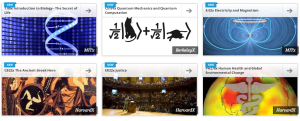As new models of digital learning sweep across higher education, colleges and universities across the globe are scrambling to get on board and make their course catalogs available to a wider audience via the Web. Of these new models, few have seen more attention than massive open online courses (a.k.a. “MOOCs”), which, starting with Khan Academy, promise to offer access to quality, affordable education at scale — online.
When it comes to innovation in learning, particularly MOOCs, it’s probably safe to say that Stanford takes the cake. While it’s hardly alone on the MOOC bandwagon, the University has long provided access to its courses and lectures online, through iTunes U, among other channels. Beyond creating a “Vice Provost of Online Learning” position within its faculty, Stanford is also in some way responsible for the most popular MOOC platforms. Coursera, Udacity and the lesser-known, group-based Venture Lab all emerged from Stanford.
Last September, the University produced yet another MOOC player, called Class2Go, which aimed to bring a new spin to the online learning model. Founded by eight engineers in Stanford’s CS Department, the non-profit platform committed itself to building (arguably the first) open-source MOOC platform — designed to be both free and interoperable with other platforms to encourage collaboration from teachers and other institutions.
Today, the other well-known name in the MOOC arena, edX, has decided to join Stanford, rather than work around it. Founded by Harvard and MIT (and launched last May), edX was East Coast Academia’s response to Coursera, Udacity and the MOOC fever beginning to grip higher education. In what is somewhat of a surprise, it isn’t the homegrown Coursera or Udacity that will be teaming up with Stanford in pursuit of open-source MOOC-ness, but the brainchild of Harvard and MIT.
Instead, Stanford and edX announced today that they will be teaming up to help realize edX’s aspiration of becoming an open-source platform to provide free and open online learning tools to higher ed institutions around the globe. To realize its open-source aspirations, edX will be essentially acqui-hiring Class2Go. Although not stated in those terms, Class2Go will no longer be focused on building its own, independent platform, and instead its team will devote all of its attention to helping edX go open-source.
In other words, Stanford will be integrating some of the features of its existing Class2Go platform into the edX platform, using Class2Go’s infrastructure as an internal platform for hosting coursework for on-campus and distance learners — both online and offline.
Since launching in September, Class2Go has attracted a number of universities (and courses) to its platform, and, while Stanford plans to keep the platform running this quarter for those already using it, the partners will look to transfer those schools and courses to edX’s platform thereafter. [This paragraph has been clarified since publication. Originally, the post stated that Stanford will be transferring universities in the coming weeks, but it will be a gradual process.]
As of June 1, the company said, developers everywhere will be able to freely access the source code of the edX learning platform, including code for its Learning Management System (LMS); Studio, a course authoring tool; xBlock, an application programming interface (API) for integrating third-party learning objects; and machine grading API’s. In addition, edX will look to encourage participation from third-party developers by providing technical and process guidelines as well as additional support.
One of the benefits of MOOC platforms is that they’re able to bring together a diverse body of students and perspectives to inform the learning process, edX President Anant Agarwal said, so the company now wants to “extend that perspective to its learning platform as well, knowing that drawing upon the global community of developers is an effective route to both transform and deliver the world’s best and most accessible online and blended learning experience.”
By turning edX into an open-source online learning platform, the company hopes to allow universities to develop their own “delivery methods,” collaborate with other institutions in ways that make sense for their needs and more effectively collect data while controlling their own branding. “Further developing online opportunities through open source technology is a key objective of the partnership between edX and Stanford,” he said.
As for Stanford, the university said that it will continue to support a number of platforms for its teachers, including continuing its partnership with Coursera. In other words, this means that Stanford will not be offering its courses through the edX platform, opting not to join the six new institutions that recently joined its platform alongside Harvard, MIT, University of California at Berkeley, the University of Texas, Wellesley College and Georgetown University, among others.
Stanford is trying to find a balance between interests, honoring the partnership it has with Coursera to make select courses available online, while still assisting edX in its mission to make the MOOC model available to one and all.
If there was any doubt over whether or not MOOCs are here to stay — or just a passing fancy — this partnership between Stanford and edX will likely put that to bed by helping to tear down the barriers to entry.
More on Class2Go here.
